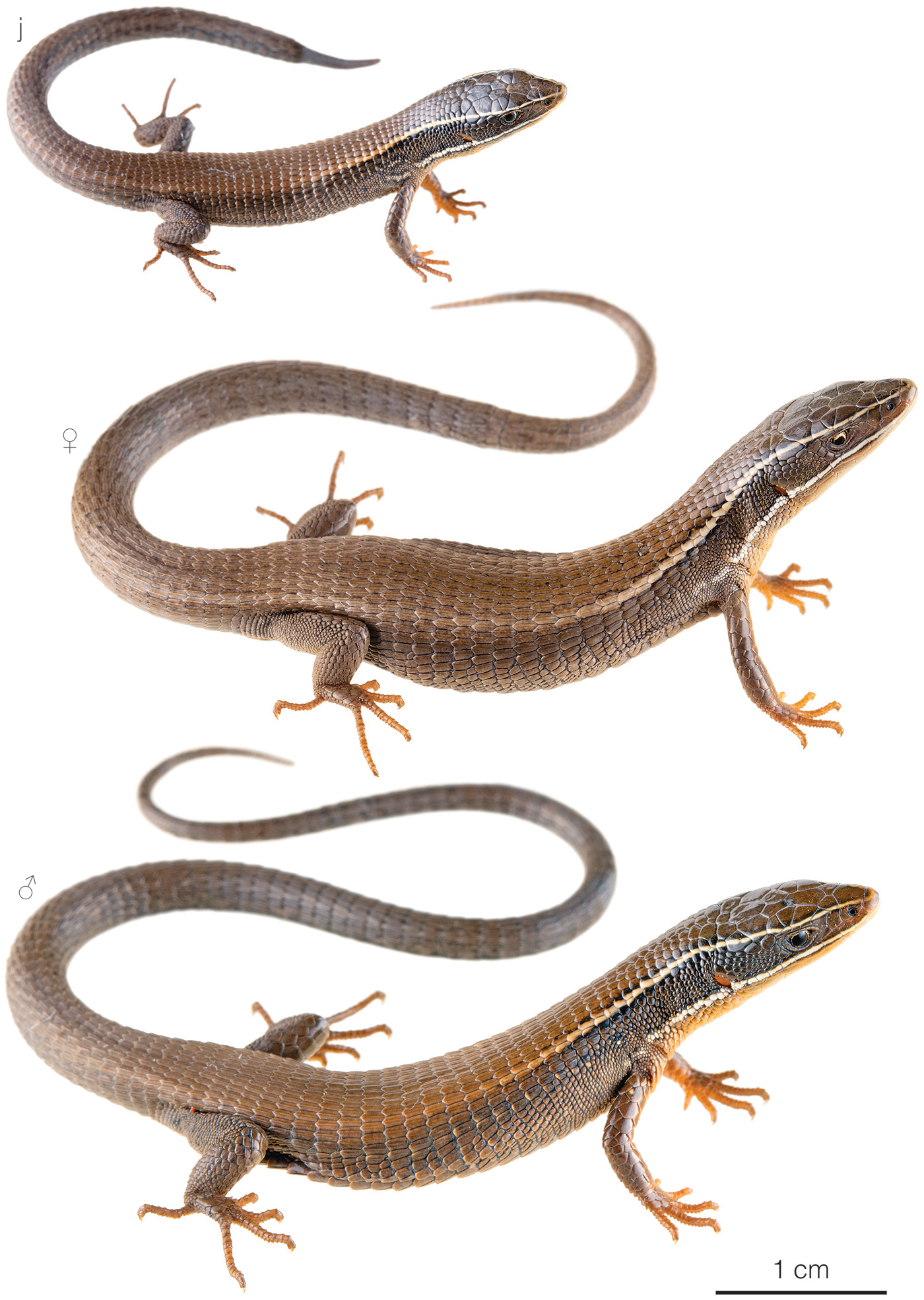Published July 21, 2021. Updated November 24, 2023. Open access. Peer-reviewed. | Purchase book ❯ |
Long-necked Sticklizard (Pholidobolus dolichoderes)
Reptiles of Ecuador | Sauria | Gymnophthalmidae | Pholidobolus dolichoderes
English common name: Long-necked Sticklizard.
Spanish common names: Cuilanpalo de cuello largo, cuilán de cuello largo.
Recognition: ♂♂ 13.7 cmMaximum distance from the snout to the tip of the tail. Snout–vent length=4.1 cm. ♀♀ 12.7 cmMaximum distance from the snout to the tip of the tail. Snout–vent length=4.8 cm..1,2 Sticklizards differ from other lizards by having short but well-developed limbs, overlapping striated sub-hexagonal dorsal scales, and a brownish dorsal pattern with longitudinal stripes.3,4 The presence of six-sided finely wrinkled dorsal scales distinguishes members of this genus from other co-occurring small brownish lizards such as those in the genera Alopoglossus, Anadia, Andinosaura, Macropholidus, and Riama.5 The Long-necked Sticklizard (Pholidobolus dolichoderes) is the only member of the genus having a long neck with granular scales, as well as an inconspicuous ventrolateral fold.1 This species can co-occur with P. macbrydei, a lizard that lacks prefrontal scales (present in P. dolichoderes).1 Males of P. dolichoderes differ from females by having dark brown, instead of light grayish-brown, body flanks.1

Figure 1: Individuals of Pholidobolus dolichoderes from the Susudel–Poetate road, Azuay province, Ecuador. j=juvenile.
Natural history: Pholidobolus dolichoderes is a locally abundant lizard that inhabits an area of seasonally dry montane shrubland, irrigated pastures, and rural houses.1,2 Most individuals have been found active during the day on the ground near spiny ground bromeliads (Puya sp.), thorny bushes, and under large rocks near rural houses with grass, but far from more disturbed areas.1 When threatened, Long-necked Sticklizards take refuge in rock piles or under thorny vegetation.2
Conservation: Data Deficient There is inadequate information to make an assessment of extinction risk..1 Pholidobolus dolichoderes was proposed to be included in this category because there is not enough information to make an accurate assessment of the species’ conservation status. The available sampling, though suggesting low abundances, is insufficient to estimate the population size.1 Unfortunately, other reptile species (including Holcosus orcesi, Stenocercus simonsii, and Dipsas oligozonata) found in the xeric inter-Andean valley of the Río Jubones are considered to be facing a high risk of extinction in the near-term future.6–8 These species are range-restricted, found nowhere else in Ecuador, and have seen ~62–70% of their native shrubland habitat destroyed. Furthermore, as is the case for P. dolichoderes,1 none of the reptiles in the area occur in protected areas.
Distribution: Pholidobolus dolichoderes is endemic to the xeric inter-Andean valley of the Río Jubones in southern Ecuador. Currently, the species is known only from around San Felipe de Oña, Azuay province (Fig. 2).

Figure 2: Distribution of Pholidobolus dolichoderes in Ecuador. The star corresponds to the type locality: Susudel–Poetate road, Azuay province.
Etymology: The generic name Pholidobolus comes from the Greek words pholidos (=scale) and bolos (=lump),9 and probably refers to the imbricated or mounted scales. The specific epithet dolichoderes, which comes from the Greek words dolikhós (=long) and derē (=neck), refers to the distinctively long neck of this species.1
See it in the wild: Long-necked Sticklizard are not easy to find. They can be seen with a ~5–7% certainty if an intense search is carried out for long periods of time at the type locality near Oña, the only place they have been recorded. The best way to find individuals of this species is to search under rocks in xeric environments during the daytime.
Authors: Amanda QuezadaaAffiliation: Tropical Herping (TH), Quito, Ecuador.,bAffiliation: Laboratorio de Herpetología, Universidad del Azuay, Cuenca, Ecuador. and Alejandro ArteagacAffiliation: Fundación Khamai, Reserva Arlequín, Ecoruta Paseo del Quinde km 56, Santa Rosa de Mindo, Pichincha 171202, Ecuador.
Academic reviewer: Jeffrey D CamperdAffiliation: Department of Biology, Francis Marion University, Florence, USA.
Photographer: Jose VieiraaAffiliation: Tropical Herping (TH), Quito, Ecuador.,eAffiliation: ExSitu, Quito, Ecuador.
How to cite? Quezada A, Arteaga A (2023) Long-necked Sticklizard (Pholidobolus dolichoderes). In: Arteaga A, Bustamante L, Vieira J (Eds) Reptiles of Ecuador: Life in the middle of the world. Available from: www.reptilesofecuador.com. DOI: 10.47051/GDKV9128
Literature cited:
- Parra V, Sales Nunes PM, Torres-Carvajal O (2020) Systematics of Pholidobolus lizards (Squamata, Gymnophthalmidae) from southern Ecuador, with descriptions of four new species. ZooKeys 954: 109–156. DOI: 10.3897/zookeys.954.50667
- Field notes, Reptiles of Ecuador book project.
- Montanucci RR (1973) Systematics and evolution of the Andean lizard genus Pholidobolus (Sauria: Teiidae). Miscellaneous Publications of the Museum of Natural History, University of Kansas 59: 1–52.
- Torres-Carvajal O, Venegas P, Lobos SE, Mafla-Endara P, Sales Nunes PM (2014) A new species of Pholidobolus (Squamata: Gymnophthalmidae) from the Andes of southern Ecuador. Amphibian & Reptile Conservation 8: 76–88.
- Peters JA, Donoso-Barros R (1970) Catalogue of the Neotropical Squamata: part II, lizards and amphisbaenians. Bulletin of the United States National Museum, Washington, D.C., 293 pp.
- Cisneros-Heredia D, Yánez-Muñoz M, Brito J, Sánchez J (2017) Holcosus orcesi. The IUCN Red List of threatened species. Available from: www.iucnredlist.org. DOI: 10.2305/IUCN.UK.2017-2.RLTS.T49981813A49981970.en
- Cisneros-Heredia DF, Valencia J, Brito J, Almendáriz A, Muñoz G (2019) Stenocercus simonsii. The IUCN Red List of threatened species. Available from: www.iucnredlist.org. DOI: 10.2305/IUCN.UK.2019-3.RLTS.T50950723A50950728.en
- Brito J, Cisneros-Heredia DF, Yánez-Muñoz MH (2019) Dipsas oligozonata. The IUCN Red List of threatened species. Available from: www.iucnredlist.org. DOI: 10.2305/IUCN.UK.2019-3.RLTS.T48617612A48617614.en
- Brown RW (1956) Composition of scientific words. Smithsonian Books, Washington D.C., 882 pp.